
| First
produced in England around 1880, novelties, salt dips, small baskets,
etc were created in creamy custard glass but it was not made in America
for nearly
five more years. The
first American
company
said
to
produce custard glass was the Dithridge Company in Pittsburgh, Penn. The quality of this glass is especially fine, but it's nearly impossible to put together a dinner set since most Dithridge pieces available now are syrups and cruets. |
| It is known that the Northwood Company of Indiana, PA. was the first to produce Custard glass for complete table settings. Some of these settings include the patterns of Inverted Fan & Feather, Chrysanthemum Sprig, Intaglio and Louis XV (see tumbler at right). All were produced prior to 1900. Many of their patterns had detailed hand painting and gilding. They even developed a blue "custard" glass that, while not really true custard, is nevertheless one of the most expensive varieties of pattern glass today. |  |
 Heisey's Winged Scroll toothpick holder ca 1898 |
Other
producers of Custard Glass prior to 1900 in the United States were A. H.
Heisey of Newark, Ohio (1897 - 1910) - see toothpick on the left,
Consolidated Lamp & Glass of Fostoria, Ohio (1894 - 1904), and the United
States Glass Co. (a merger of several factories 1901 -1910). Other companies that followed after 1900 were Tarentum Glass Co. of Tarentum, PA. (1900 - 1905) - see Georgia Gem pattern butter dish below. They also produced a similar type color of green in a few of their table set patterns, H. Northwood Co. of Wheeling, West Virginia |
| (1902 - 1922), Jefferson Glass Co. of Steubenville, Ohio (1904 - 1915), Dugan & Diamond Glass of Indiana, PA. (1904 - 1915), Coudersport Glass of Coudersport, PA. (1900 - 1904), Fenton Glass Co. of Wheeling, West Virginia (1907 - 1913), Imperial Glass Co. (1908), Cambridge Glass Co. (1908 - 1920), and McKee Co. of Jenette, PA. (1915 - 1930). | 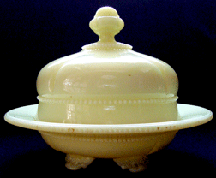 |
| Two of the only companies making custard glass today are Fenton and Boyd Glass, but in smaller amounts and as specialty items for collectors. With all the cream-colored glass on the market, how can you tell if you've found a piece of genuine custard glass? Buy a small, portable black light and don't leave home without it when you go on a custard-glass trek. | 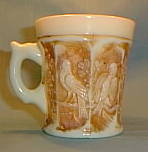 |
 |
First, hold the glass to the light and check
for
opalescence, then bring out your trusty light. The
minute you shine black light on the piece you'll know for sure whether
or not it's custard glass because the genuine article will take on
an unearthly, luminous glow. This mug is Northwood's Singing Birds pattern. |
| And the magic ingredient? Uranium salts, which were also a common ingredient in producing brightly colored yellow and green glass for more than a hundred years. In custard glass, uranium is what gives the glass its deep cream color. In fact, if you have a Geiger counter handy, you will also get a positive reading on custard and any other form of uranium glass. Before you run to store it in a lead-lined container, be aware that the levels of uranium used in even a large collection of uranium glass have been found to be no more harmful the ones we are exposed to each day from our microwaves and TVs. In fact, that unique ingredient is what makes the glass so favored by collectors today. |
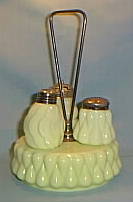 |
Little uranium glass has been produced since World War II, when the atomic bomb made it desirable for the military to restrict access to the element and glass workers became hesitant to use it due to its radioactivity. Though the military lifted those restrictions a decade later, few companies use the element in glass creation now. Other chemicals have been produced that can create the same colors, and strict health regulations requiring special handling and storage of uranium in glass production make it highly unlikely that custard glass will ever be produced in any substantial quantity again. |
| Okay,
this is a test to see what you've learned from Tammy's article. What
are these curtain tiebacks made of? |
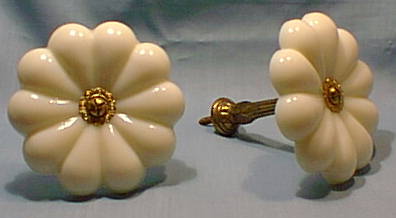 |
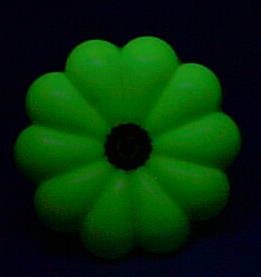 |
No doubt about it, they pass the black light test and are genuine Custard Glass!! |
With additional contributions by Mike Coulon
If you are interested in purchasing some
Early American custard glass, go HERE.


